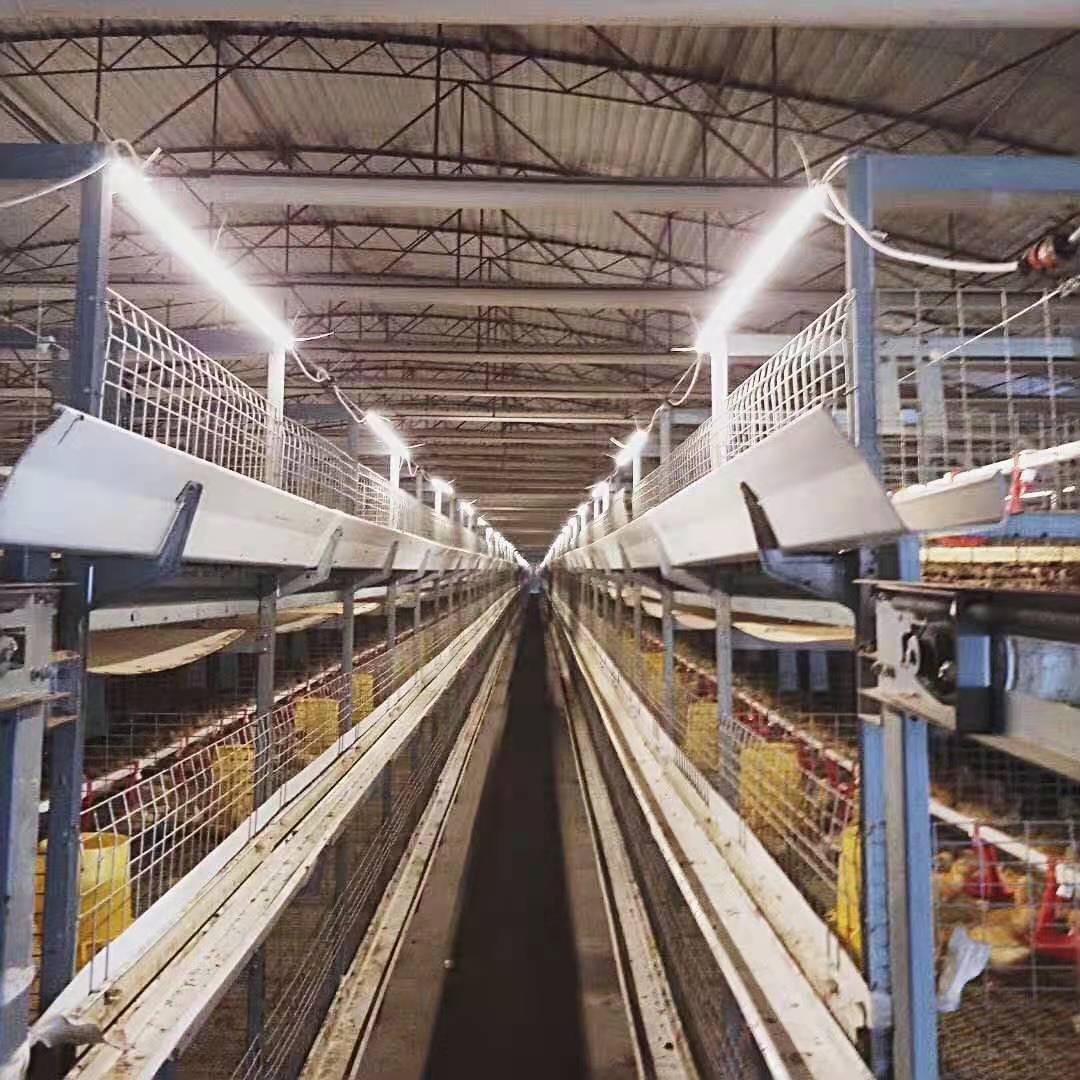Farming factory lighting application-waterproof tube
The cold light source of the LED waterproof light tube controls the lighting of the chicken house, and with the heat dissipation system, the mood of the laying hens will be more stable and easier to raise. Among them, red light can stimulate egg production, green light can increase egg size, and a single light source can increase the survival rate of young hens. So in theory, the laying hens will lay more eggs, and the taste of the eggs will be better.
The use of LED lights for breeding in chicken farms is certainly a new thing and a new idea. However, we should first know how to use LED waterproof tubes in chicken farms. There is a lot of knowledge in this, and this article will discuss it for everyone.
It should be understood that the poultry farming industry is usually very conservative, and it must take a while before it can accept LED technology. However, now the poultry farming industry has completely embraced LED technology and its energy-saving benefits. In the past few years, increasingly sophisticated LED technology has gradually met the lighting needs of the poultry farming industry.
A good LED waterproof tube can save 80% to 85% energy than an incandescent lamp. But not all LED lights are the same. Practitioners in the aquaculture industry should spend time researching LED lights before buying. All LED lamps are more expensive than incandescent lamps, so you definitely don't want to make mistakes and waste silver.
Lighting is an important environmental factor in the poultry farming industry. Lighting affects production efficiency, animal welfare, and growth rate. The four major elements of light are intensity, period, source and spectral range. The color of light depends on the different wavelengths in the visible spectrum.
White light includes all
wavelengths in the visible spectrum. But even the same white light will show
different color temperatures due to the different energy emitted by different
wavelengths. Therefore, poultry farmers should not try to use LED bulbs lightly
without asking for details or consulting trusted sources. LED field test
LED field test
Fortunately, many well-known universities in the United States, including Mississippi State University, Auburn University, University of Georgia, University of Arkansas, University of Maryland, University of Delaware, etc., when LED first entered the poultry industry The test. After numerous field tests, these promoters have evaluated a variety of different LED products and provided fair evaluation results on the cost analysis, investment recovery potential and service life of the products. These evaluation results are provided free of charge, so please feel free to request and study carefully to help you make the right purchase decision.
Please do not choose LED bulbs that have not been field-proven in the chicken house. Due to the influence of dust, humidity and ammonia, the environment of chicken coops is much harsher than that of houses and businesses. Some bulbs are not designed for such an environment, nor can they stand the test of these factors.
The energy-saving performance of LED is impeccable. The question farmers have about LEDs is, will poultry perform as well under LED lights as they do under incandescent lights?
The answer is yes, but it needs to be under conditions where there is sufficient light during the hatching and growth period, the dimmer is working properly, and the poultry is well taken care of. In this way, the performance of poultry under the LED light will be as good as under any other light source.
What effect does LED have on poultry?
Many farmers have switched from compact fluorescent lights to LED lights and found that the temperament of the poultry has become more docile. This may be because LED lights do not flicker like fluorescent lights. Because chickens have sharper eyesight than humans, chickens are more susceptible to flashing lights.
To some extent, LED technology is ahead of dimmer technology, so not all dimmers can be adapted to LED bulbs. As a result, the LED bulb cannot be dimmed in a linear manner like an incandescent lamp (the so-called linear means that when the dimmer is dimmed by 20%, the brightness of the bulb is also dimmed by 20%). On LED lights, the dimmer may need to be adjusted very greatly to make the LED lights show a little darkening. Dimmer manufacturers are also struggling to catch up, but there are still many old dimmers on the market that need to be upgraded to accurately adjust the brightness of the LED lights.
Some dimmers may only need to install an upgrade chip to work normally, but some dimmers are too old and can only be replaced with newer products to adapt to more advanced LED technology.
Choose LED bulbs with appropriate color temperature. The color temperature is expressed in Kelvin temperature units (Kelvin). The warm light is from 2700 to 3000, similar to incandescent light or high-pressure sodium light, with orange-red color. Natural light ranges from 3400 to 3700 Kelvin. The cold light has a bluish-white color, ranging from 5000 to 6000 Kelvin.
At present, the color temperature of the most widely used LED light in broiler chicken breeding is 5000 Kelvin, while the most widely used in breeder chicken breeding is 2700. Again, not all LED lights are suitable for breeding. A high-quality household omnidirectional LED light is not the best choice for chicken coops.
About 40% of the omnidirectional LED waterproof tubes can illuminate the roof and walls, which may be good for houses, but not practical for chicken coops, because chicken coops require most of the lights to shine directly on the ground.
For this reason, it may be necessary to purchase high-wattage LED lights to meet the needs of chickens. These lights are more expensive than low-wattage LED lights. Most of the LED lights sold in hardware stores or discount stores are omnidirectional lights.
Even the cheapest LED lamps are more expensive than incandescent lamps, so please make sure that the LED lamps you buy are what you need. You need to understand the unit of luminous flux and the meaning of luminous flux readings in use. Your after-sales technician may bring an illuminance meter to the chicken house to measure the lighting effects on the spot.
Foot-candle is a unit of light intensity, which can measure the light intensity of different light sources. One footcandle is equal to one lumen falling on an area of one square foot. 1 lumens is equal to the total emitted luminous flux produced by 1 candle at a solid angle, which reflects the brightness. For example, a 10W 19A non-dimmable LED bulb may have a brightness of 900 lumens; a 6W 19A dimmable LED bulb may have a brightness of 530 lumens.
Chicks usually require 2 foot candles or more during 4-14 days of birth, depending on the breed and nutritional plan. However, the light must be adjusted to a very dark level (0.03 foot candles or lower) in the subsequent period to keep the chickens in good growth condition. Proper light intensity is the key to maintaining poultry condition. The light should be much higher than the feeding trough and try not to illuminate the wall. Even lighting of the chicken house is very important, and there should not be too dark or too bright areas.
LED manufacturers are constantly improving their processes to avoid dark spots and reduce the range of excessive brightness. Accurate lighting angles can help direct light to poultry and reduce wasted light on walls and ceilings.
How does LED perform in the farm?
.
This article has been authenticated by the original "original", and the author has enriched Xianwen. Visit yuanben.io to query [57CRP17S] for authorization information
It may not be used in any way, including but not limited to reprinting, extracting, copying, or creating mirror images. Offenders must be investigated.
The entry is created, edited and maintained by Guangdong Zhengfa Technology. If you find that the content of the entry is suspected of infringement, please contact us via E-mail: gm@cn-led.net, and we will deal with it in a timely manner in accordance with relevant laws and regulations. Without permission, commercial websites, etc. are prohibited from copying and grabbing the contents of Toutiao Encyclopedia; reasonable users, copyright cooperation E-mail: gm@cn-led.net, please indicate the source from www.cn-led.net. Feedback 2020 cn-led.net
 English
English china
china German
German Spanish
Spanish French
French Italian
Italian Portuguese
Portuguese Japanese
Japanese Korean
Korean Arabic
Arabic Russian
Russian
 Mobile Site
Mobile Site
 +86-0769-81305858
+86-0769-81305858